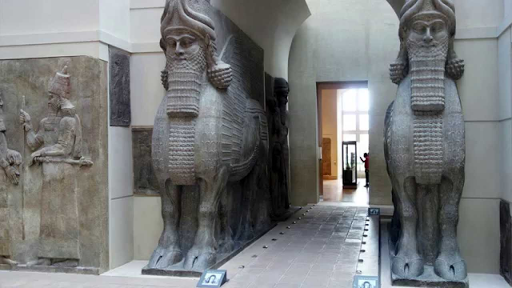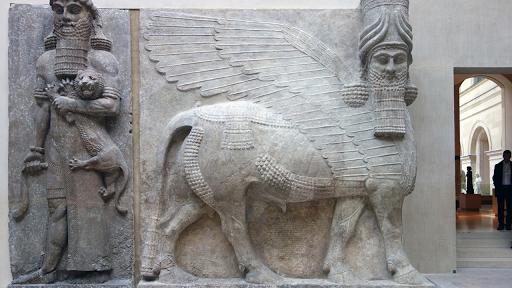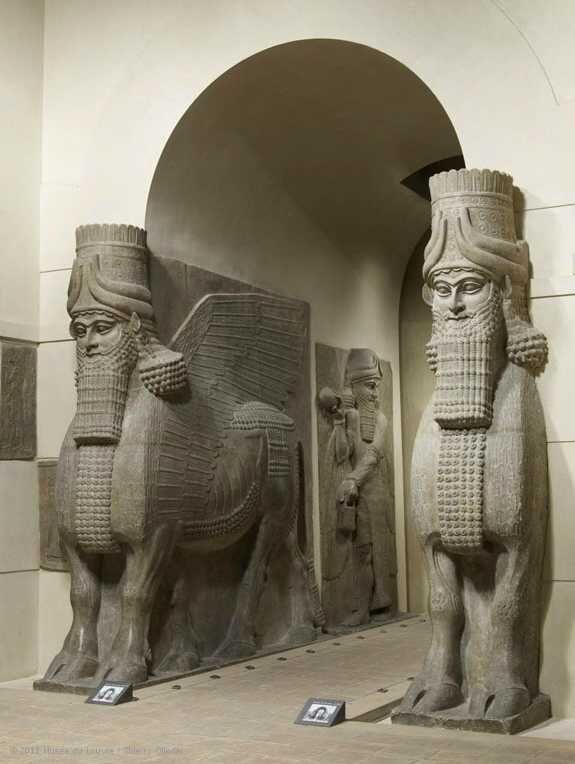Suddenly I was transported back to rainy afternoons in London as a child looking up the lamassu that have been displayed in the British Museum since they were taken from Assyrian sites in the. The first change was the capital was moved to Dur Sharrukin present day Khorsabad and second the Lamassu was presented on a bulls body compared to a lions and seems to be slightly smiling.

Lamassu From The Citadel Of Sargon Ii Video Khan Academy
Furthermore where were the lamassu sculptures originally displayed.

. Babylonian protective demon with a bulls body eagles wings and a human head. The Roman work known as the Pont-du-Gard is aan. The Lamassu sculptures were recovered from where.
A Sargons palace b Gudeas Lagash c Ashurbanipals palace d Ziggurat at Ur Which of the following played an important role in the shaping of modern art. First of all the figure has five legs. It is 164cm tall and 343cm long which is larger than an actual average lion.
The Assyrian lamassu sculptures are partly in the round but the sculptor nonetheless. Where were the Lamassu sculptures originally displayed. Porada Edith and Susanna Hare.
What ethnic group is credited with the first system of writing known to man. Metropolitan Shows Works That Date to 5000 Years Ago -- Diverse Races Covered The New York Times p. Near-Eastern Art Placed on Display.
Lamassu bull-man Lamassu. Assyrians Reliefs in the Metropolitan Museum of Art. The Ziggurat at Ur was a fortress funerary monument palace temple platform Where were the Lamassu sculptures originally displayed.
In particular theres one unique trait that stands out in many of these carvings. Chicagos bull seems to have been on display undisturbed since 1931. Hellenistic sculpture differs from Classical in all of the following except.
Assyrian Lamassu from the Citadel of Sargon II Khorsabad Iraq c. Which work has a king approaching the god Shamash. Lamassu are human-headed eagle-winged bulls or lions who once shielded cities in Mesopotamia.
Which is not true for Middle Byzantine architecture. 883-612 large monumental bulls often with wings and always with human heads were placed as gateway guardians at the entrances of royal palaces like Khorsabad and Nineveh. Assyrian sculpture typically placed prominent pairs of lamassu at entrances in palaces facing the street and also internal courtyards.
The Assyrians envisioned a protective spirit that was part bull and part human and sometimes part eagle. Human-headed Winged Lion is a raised relief sculpture of a Lamassu with the body of a lion made of gypsum alabaster. The most famous colossal statues of Lamassu have been excavated at the sites of the Assyrian capitals established by King Assurnasirpal II reigned 883 859 BCE and King Sargon II reigned 721 705 BCE.
In the Assyrian mythology there were human headed winged bullslions that were protective genies. The Metropolitan Museum of Art p. Which is the oldest.
This replica was made with 10000 Iraqi date syrup cans and serves as a symbol of. The most famous colossal statues of Lamassu have been excavated at the sites of the Assyrian capitals created. Click to see full answer.
Then in April 1991 Michael Bourbon master conservator from Paris arrived in Chicago to create a silicone and plaster cast of the lamassu. An American professor named Michael Rakowitz was commissioned to recreate this Lamassu sculpture and it is now displayed in Trafalgar Square in London. -So this is modern day Khorsabad.
The Lamassu sculptures were recovered from where. They have been thought to be very strong animals and functioned both as a clear reminder of the kings supreme authority and symbols of security for all people. This makes the lamassu very interesting pieces of ancient Mesopotamian and Persian art.
There are several fun facts about this sculpture. A replica of Chicagos bull was made and displayed at. It comes from Mesopotamia and is believed to.
Intended for public display. The lamassu are human-headed winged lions or bulls therere many pairs of these sculptures that are still in existence including those in the British MuseumLondon LouvreParis and Metropolitan Museum of ArtNew York as well as several in Iraq. They were represented as double-aspect figures on corners in high relief.
What ethnic group is credited with the first system of writing known to man. -Were in a room in the Louvre filled with sculpture from the Assyrians who controlled the ancient Near East from about 1000 BCE to around 500 BCE. The lamassu have five feet.
Larger wider naves. It was originally made for Hatshepsuts funerary temple at Deir el-Bahri which is a complex of temples dedicated to pharaohs of her family. 720 BCE These large monsters served to ward off the kings enemies and were often placed in pairs to guard palace entrances.
Hence they were apotropaic or tutelary figures. You can see them at Gate of All Nations at Persepolis in Iran the British Museum in London the Louvre in Paris the National Museum of Iraq in Baghdad the Metropolitan Museum of Art in New York and the University of Chicago Oriental Institute. The Great KingKing of Assyria.
-And these sculptures in particular come from the palace of Sargon the 2nd and were carved at the height of Assyrian civilization in the 8th century BCE.
Human Headed Winged Bull Lamassu Assyrian Neo Assyrian The Metropolitan Museum Of Art

Lamassu Symbol For Protection Indrosphere

25 Lamassu From The Citadel Of Sargon Ii Dur Sharrukin Modern Iraq Ap Art History
Colossal Lamassu Sculpture From The Palace Of Sargon Ii At Khorsabad Sargon Ii Google Arts Culture

Lamassu Backstory Article Assyrian Khan Academy

Lamassu History 2701 Wiki Fandom

Lamassu Backstory Article Assyrian Khan Academy
Human Headed Winged Lion Lamassu Assyrian Neo Assyrian The Metropolitan Museum Of Art
0 comments
Post a Comment